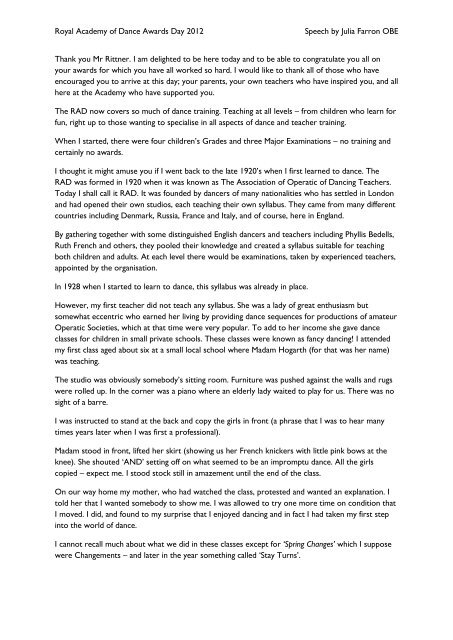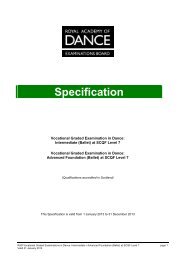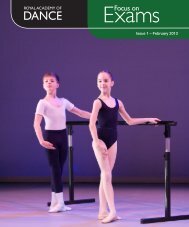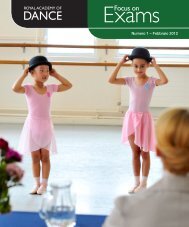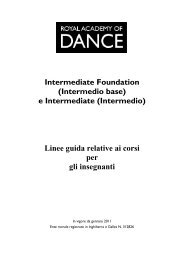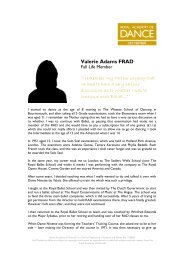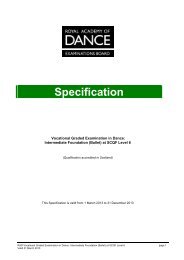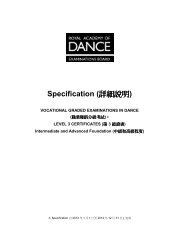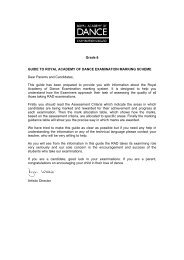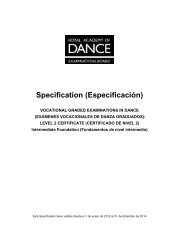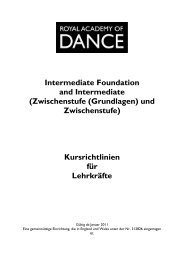Read Julia Farron's speech - Royal Academy of Dance
Read Julia Farron's speech - Royal Academy of Dance
Read Julia Farron's speech - Royal Academy of Dance
Create successful ePaper yourself
Turn your PDF publications into a flip-book with our unique Google optimized e-Paper software.
<strong>Royal</strong> <strong>Academy</strong> <strong>of</strong> <strong>Dance</strong> Awards Day 2012 Speech by <strong>Julia</strong> Farron OBE<br />
Thank you Mr Rittner. I am delighted to be here today and to be able to congratulate you all on<br />
your awards for which you have all worked so hard. I would like to thank all <strong>of</strong> those who have<br />
encouraged you to arrive at this day; your parents, your own teachers who have inspired you, and all<br />
here at the <strong>Academy</strong> who have supported you.<br />
The RAD now covers so much <strong>of</strong> dance training. Teaching at all levels – from children who learn for<br />
fun, right up to those wanting to specialise in all aspects <strong>of</strong> dance and teacher training.<br />
When I started, there were four children’s Grades and three Major Examinations – no training and<br />
certainly no awards.<br />
I thought it might amuse you if I went back to the late 1920’s when I first learned to dance. The<br />
RAD was formed in 1920 when it was known as The Association <strong>of</strong> Operatic <strong>of</strong> Dancing Teachers.<br />
Today I shall call it RAD. It was founded by dancers <strong>of</strong> many nationalities who has settled in London<br />
and had opened their own studios, each teaching their own syllabus. They came from many different<br />
countries including Denmark, Russia, France and Italy, and <strong>of</strong> course, here in England.<br />
By gathering together with some distinguished English dancers and teachers including Phyllis Bedells,<br />
Ruth French and others, they pooled their knowledge and created a syllabus suitable for teaching<br />
both children and adults. At each level there would be examinations, taken by experienced teachers,<br />
appointed by the organisation.<br />
In 1928 when I started to learn to dance, this syllabus was already in place.<br />
However, my first teacher did not teach any syllabus. She was a lady <strong>of</strong> great enthusiasm but<br />
somewhat eccentric who earned her living by providing dance sequences for productions <strong>of</strong> amateur<br />
Operatic Societies, which at that time were very popular. To add to her income she gave dance<br />
classes for children in small private schools. These classes were known as fancy dancing! I attended<br />
my first class aged about six at a small local school where Madam Hogarth (for that was her name)<br />
was teaching.<br />
The studio was obviously somebody’s sitting room. Furniture was pushed against the walls and rugs<br />
were rolled up. In the corner was a piano where an elderly lady waited to play for us. There was no<br />
sight <strong>of</strong> a barre.<br />
I was instructed to stand at the back and copy the girls in front (a phrase that I was to hear many<br />
times years later when I was first a pr<strong>of</strong>essional).<br />
Madam stood in front, lifted her skirt (showing us her French knickers with little pink bows at the<br />
knee). She shouted ‘AND’ setting <strong>of</strong>f on what seemed to be an impromptu dance. All the girls<br />
copied – expect me. I stood stock still in amazement until the end <strong>of</strong> the class.<br />
On our way home my mother, who had watched the class, protested and wanted an explanation. I<br />
told her that I wanted somebody to show me. I was allowed to try one more time on condition that<br />
I moved. I did, and found to my surprise that I enjoyed dancing and in fact I had taken my first step<br />
into the world <strong>of</strong> dance.<br />
I cannot recall much about what we did in these classes except for ‘Spring Changes’ which I suppose<br />
were Changements – and later in the year something called ‘Stay Turns’.
<strong>Royal</strong> <strong>Academy</strong> <strong>of</strong> <strong>Dance</strong> Awards Day 2012 Speech by <strong>Julia</strong> Farron OBE<br />
It took me years to work out that they were, in fact, Grand Jetes en tournant, which was somewhat<br />
ambitious for a child aged six!<br />
At the end <strong>of</strong> the year, Madam said I should go to a proper school. My mother was puzzled; she<br />
thought I was already at a proper school. She took the advice and we were introduced to a school<br />
run by three sisters, Grace Lillie and Valerie Cone.<br />
The school was already well established and taught both the Cecchetti system and the new RAD<br />
syllabus. The head <strong>of</strong> the school, Miss Grace Cone had studied with Cecchetti who was teaching in<br />
London at that time.<br />
I was directed to a teacher who taught children the new syllabus. She had studied dance and was an<br />
inspiring teacher with great musicality, humour and a love <strong>of</strong> movement, all essential if you want to<br />
teach. She later became a much loved children’s examiner for the RAD. There were only about eight<br />
or ten <strong>of</strong> us in the class and within about two years we had passed from Grade 1 to Grade IV. An<br />
examiner used to come to the school – we loved those occasions. At the end <strong>of</strong> each Grade, there<br />
was a dance to perform – very short – each Grade had its own solo, an Irish Jig, a Scottish Reel, a<br />
Sailor’s Hornpipe and a Hungarian Peasant <strong>Dance</strong>. Looking back, this was the icing on the cake. We<br />
all loved performing and in fact we all became pr<strong>of</strong>essionals, either in ballet, acting, skating or film.<br />
After we had gained our five Grades (one more exam had been added by then) we passed over to a<br />
different teacher for the Major Work. From Elementary onwards, we made a visit to Holland Park<br />
(the Headquarters <strong>of</strong> the <strong>Academy</strong>) for our examinations. The Association rented two floors in a big<br />
house. On the ground floor they had <strong>of</strong>fices and down in the basement, they had built a dance studio<br />
out into the garden. There we gathered for our Major Examinations. The examiners were<br />
distinguished and they say at a long table (<strong>of</strong>ten four or five <strong>of</strong> them). I can still remember the<br />
tension as we waited for the studio door to be opened. For Elementary, there were eight or ten<br />
girls and we were examined by these very grand ladies and gentlemen, who could not resist on<br />
occasion, standing up ad correcting us.<br />
The atmosphere was tense and I can recall one or two <strong>of</strong> the girls for whom the experience proved<br />
to be overwhelming and who had to be escorted out in tears into the arms <strong>of</strong> waiting parents and<br />
teachers.<br />
Intermediate and Advanced followed the same pattern, although there were fewer entrants. But the<br />
examiners did still, on occasion, stand up to correct something. I recall the great dancer Idzikowsky<br />
coming to me and holding my hands to help me jump high enough to do an Entrechat Six.<br />
Later, the Solo Seal was added. This was very different. We did a barre and a short set <strong>of</strong><br />
enchainements in the Centre. After this you left the room to change into a white tutu, returning one<br />
by one to present a dance which had been choreographed by the RAD. After that, you changed into<br />
a costume <strong>of</strong> your choice for a second variation which had to be choreographed by you with no help<br />
from your teacher. You were however permitted the assistance <strong>of</strong> your pianist in choosing suitable<br />
music for a Demi Caractere solo. I was lucky to have a really good and helpful pianist.<br />
This was quite an occasion. The examiners were <strong>of</strong> the highest order. Dame Adeline Genee, who<br />
was our President, sat in the centre <strong>of</strong> the table wearing hat and gloves as if she were attending a<br />
garden party.
<strong>Royal</strong> <strong>Academy</strong> <strong>of</strong> <strong>Dance</strong> Awards Day 2012 Speech by <strong>Julia</strong> Farron OBE<br />
That took one to the end <strong>of</strong> the course. Because I was still at school, I was encouraged to go over<br />
to the Cecchetti syllabus, but soon gained a scholarship to attend classes at Sadler’s Wells, which<br />
Ninette de Valois had opened in order to provide dancers for her company. The school introduced<br />
me to a mixture <strong>of</strong> both Cecchetti and Russian systems.<br />
This led to my career with Sadler’s Wells, later becoming The <strong>Royal</strong> Ballet, and 25 years later, I<br />
commenced my second career as a teacher.<br />
How different are things now – you have so many courses for both teachers and dancers. It took<br />
many years to get to the teaching courses and examinations – now look at the choice you have. And<br />
how wonderful to have carefully selected music which inspires and supports both the dancers and<br />
the teachers all over the world. This gives me a great opportunity to say Congratulations to the<br />
RAD, what an achievement!<br />
I do hope that you will have as much enjoyment as I had as both dancer and teacher.<br />
Let me, before I leave, give you a little advice, given to me by Dame Ninette De Valois, who said, ‘As<br />
you finish a class, leave them laughing!’. She did it, I tried it, it worked!<br />
Good luck to you all, and once again, many congratulations. Thank you.


